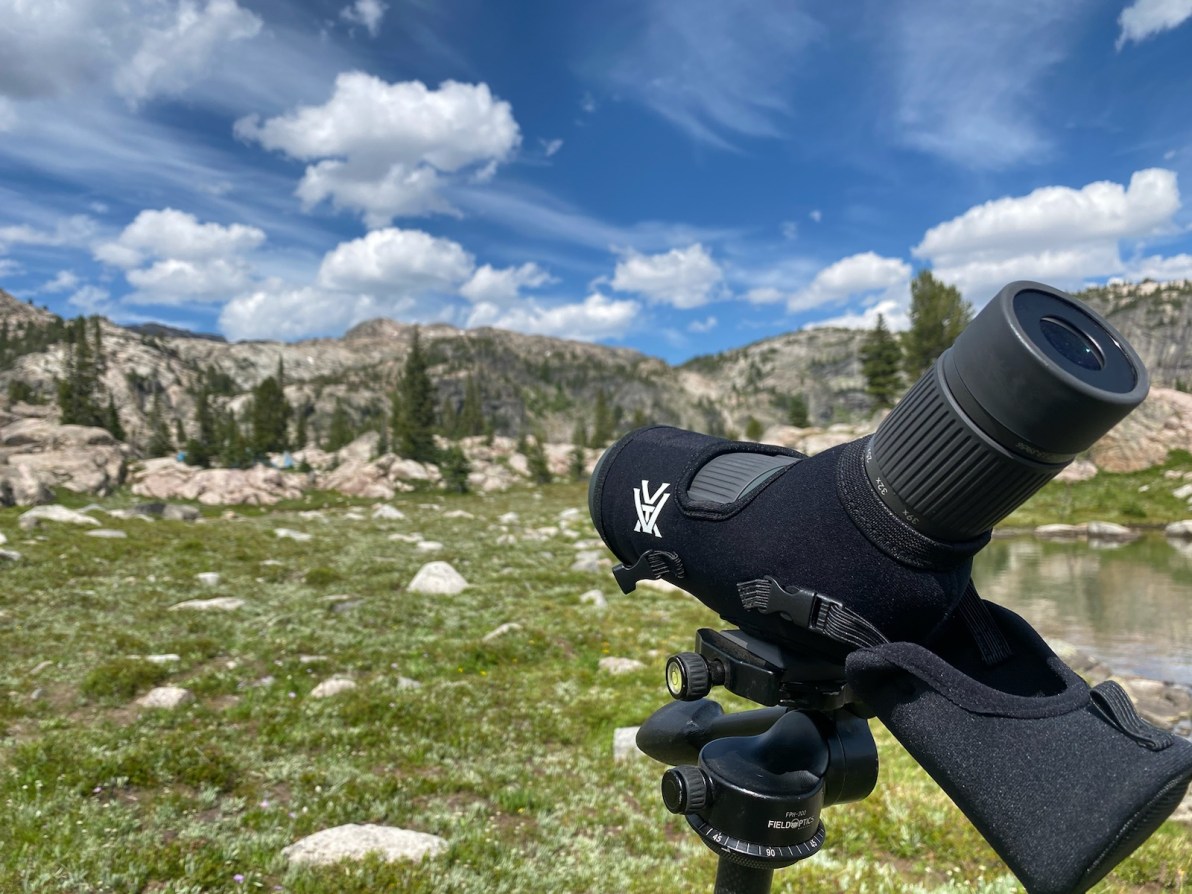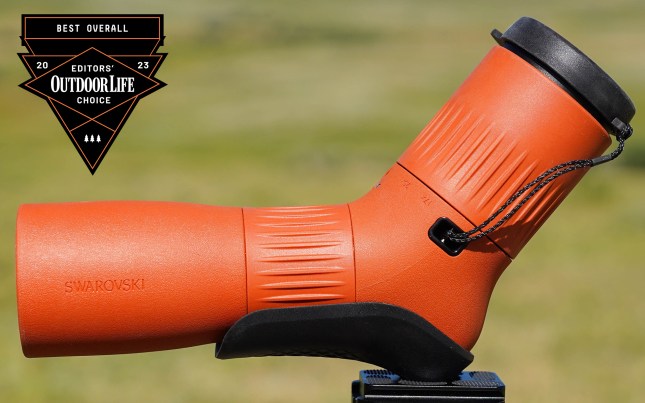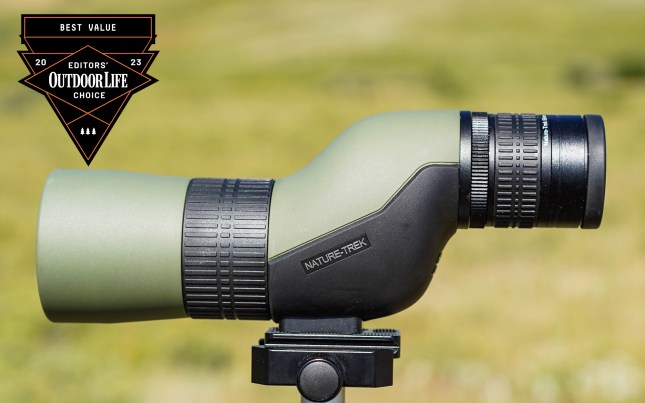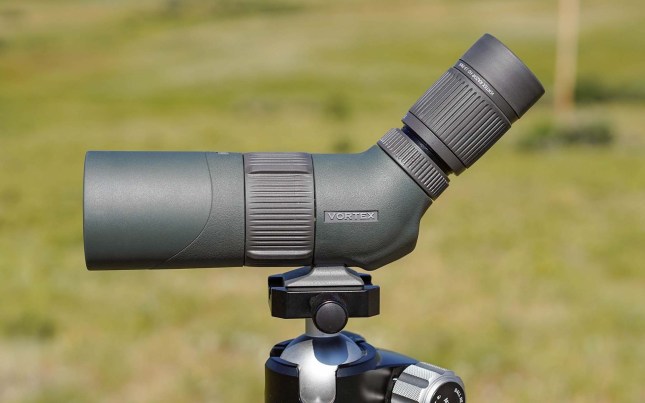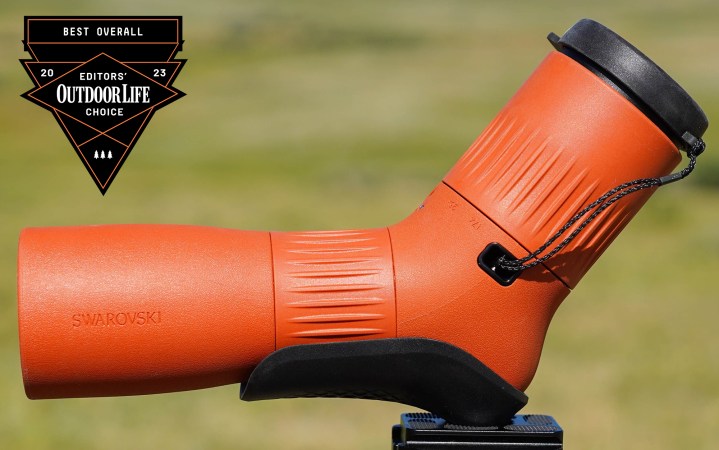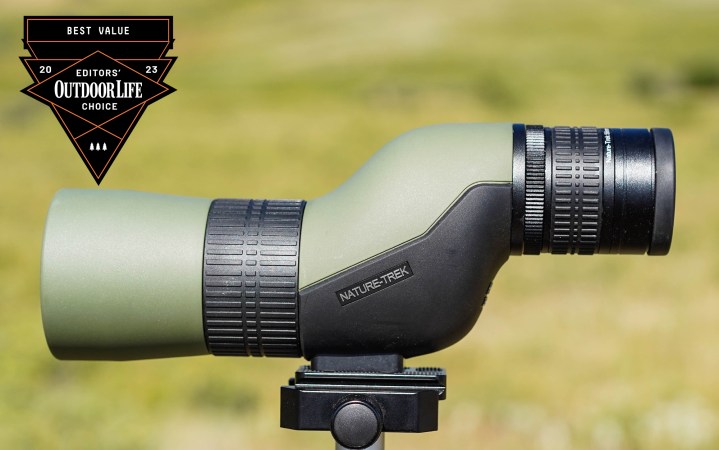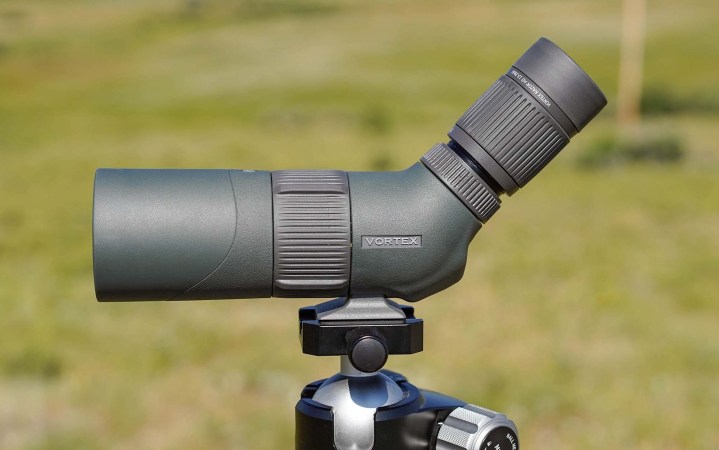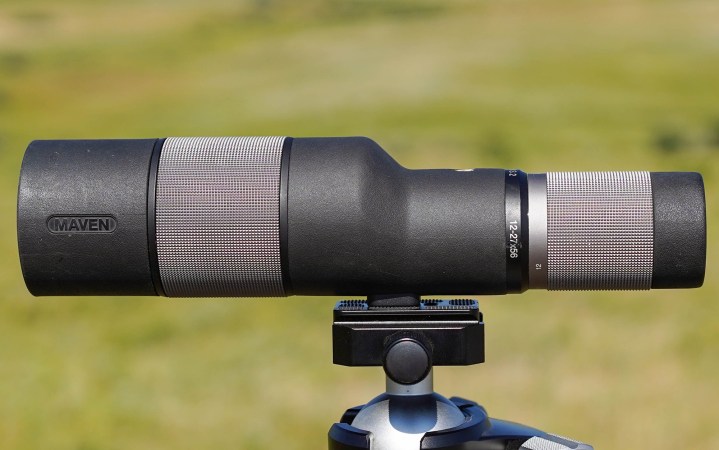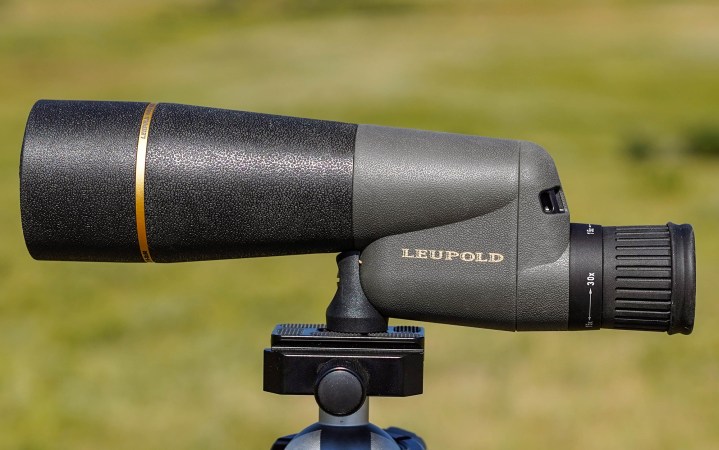We may earn revenue from the products available on this page and participate in affiliate programs. Learn More ›
As field optics go, big 80mm and larger spotting scopes aren’t for everyone. They’re heavy, bulky, and require a heavy tripod to stabilize, so if you’re doing any hiking or backpacking, it can be hard to justify their weight-to-visibility advantage.
I mainly use my big spotters either from a base camp, close to my pickup, or in situations where I carry little besides the optic and tripod. In most other cases, whether hunting, bird-watching, or hiking, where mobility is key to success, a smaller spotting scope is a smarter choice.
Most wildlife watchers gravitate to scopes with a 65mm objective lens, classified as mid-sized spotters. They provide a good balance between packability and optical horsepower, since most have magnification ranges in the 15- to 45-power range.
But the industry is recognizing that many customers want an even smaller, lighter, and more packable spotting scope. Welcome to the true compacts. This is a relatively new class of optics with 50mm to 56mm objective lenses and magnifications in the 15- to 30- or even 40-power range. They’re designed to pick up where big 15x56mm binoculars leave us, to reach out to middle distances to count points on a bull or identify a cryptic warbler. They’re about one-third the weight of a big 86mm unit, and because they don’t always require a tripod, they are among the lightest and most useful field optics.
We put five of the best compact spotting scopes up against each other in our first test of this category. They cover the landscape from the ultra-premium Swarovski, which retails for $2,500, to a very useful $320 Hawke. Most have angled, non-removable eyepieces. Some are brand new for this year, others have been on the market for a couple years. They share a small stature, weights around 2 pounds, and very good optics for their size.
- Best Overall: Swarovski ATC 17-40×56
- Best Value: Hawke Nature-Trek 13-39×56
- New Launch: Vortex Razor HD 13-39×56
- Maven S.2
- Leupold Gold Ring Compact 15-30×50
How We Tested the Best Compact Spotting Scopes
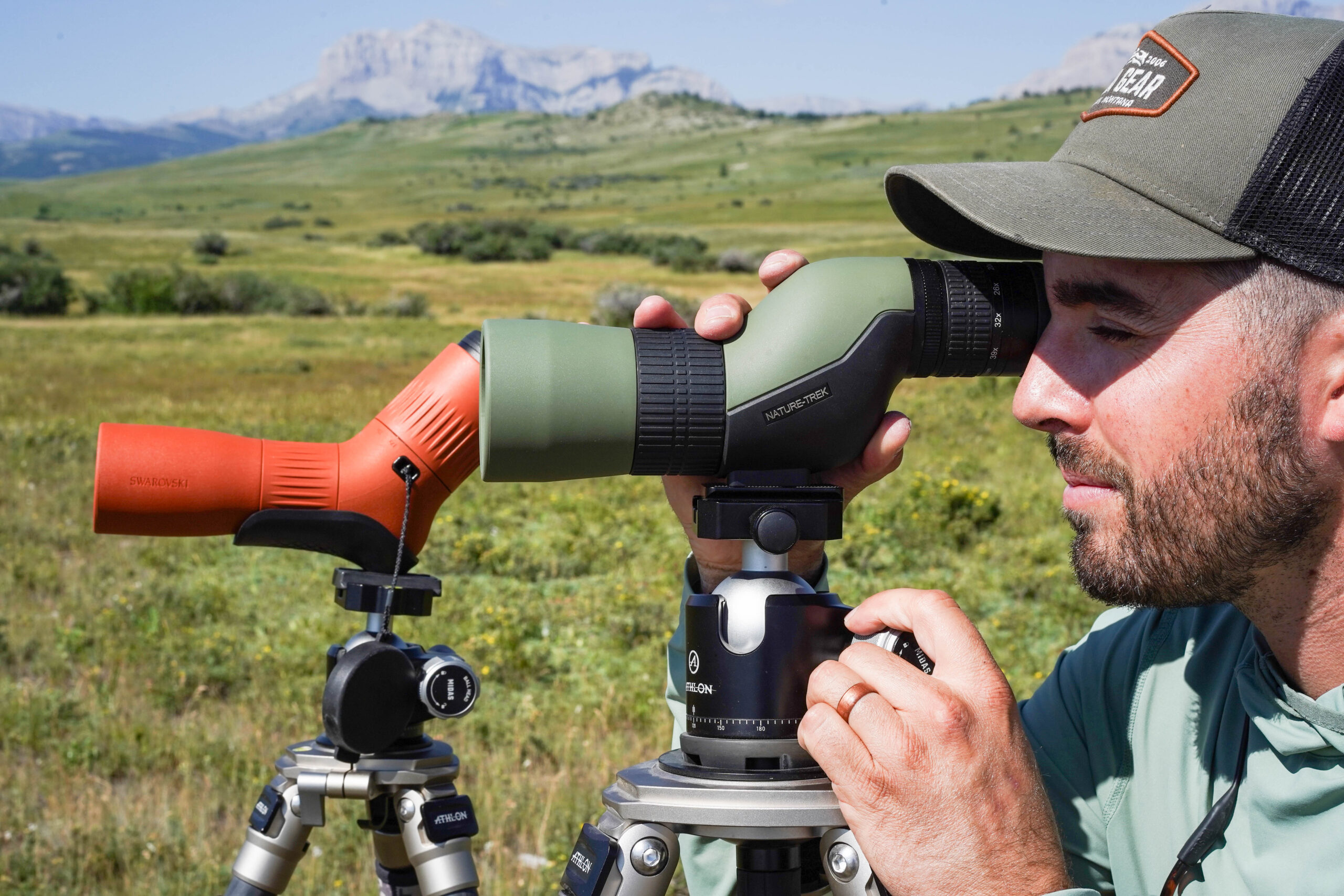
Just like other categories in our annual optics test, we put the compact spotters through a series of objective and subjective evaluations, measuring everything from their optical performance to their packability and controls. In the course of our test, we found some gems, but also some duds, and tried to describe our findings in ways that will be useful to potential buyers.
Spotting scopes represent one of the largest investments a hunter or shooter makes, so it’s natural that we spend a disproportionate amount of time and energy researching different brands, models, designs, and sizes before we make a buying decision. That same deliberate attention to performance and value defines every category of Outdoor Life’s optics test, but especially spotters. Plus, consumers are starved for objective, reliable information, as marketers blur the definitions of glass quality and often exaggerate specifications such as field of view and actual magnification.
That’s where Outdoor Life’s optics test can save you hundreds of dollars and years of literal headache from squinty glass. We are not obligated to any brand or advertiser, and our testers aim to squeeze the very best performance from every submission.
Our Test Methodology
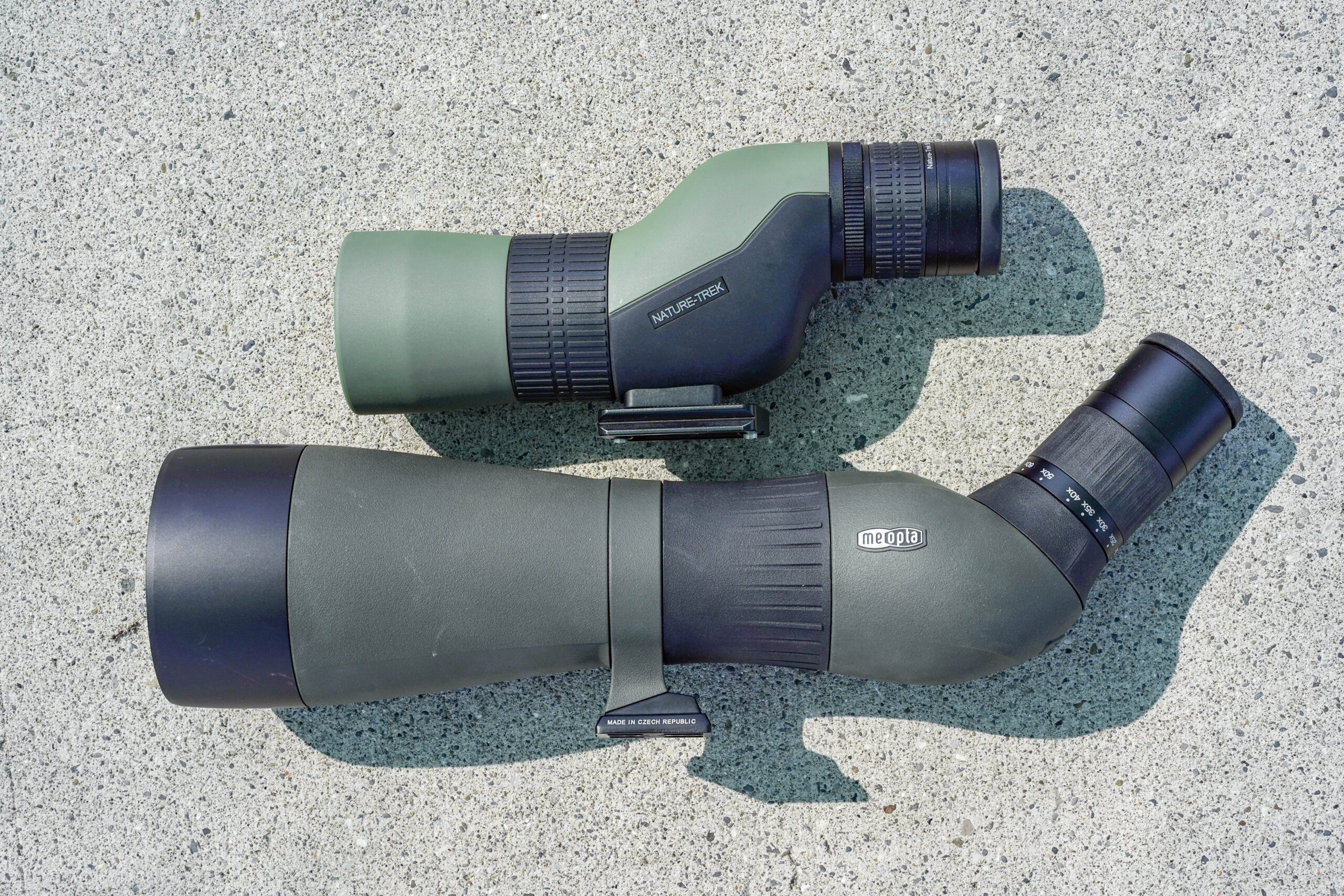
We invited manufacturers to submit any new spotting scopes introduced from mid-2022 through 2023. Because this particular category of sports optics is expensive to manufacture, and because the market isn’t nearly as dynamic as riflescopes or binoculars—after all, once you’ve purchased a spotting scope, you’re unlikely to be in the market for another—we test spotters only every two or three years.
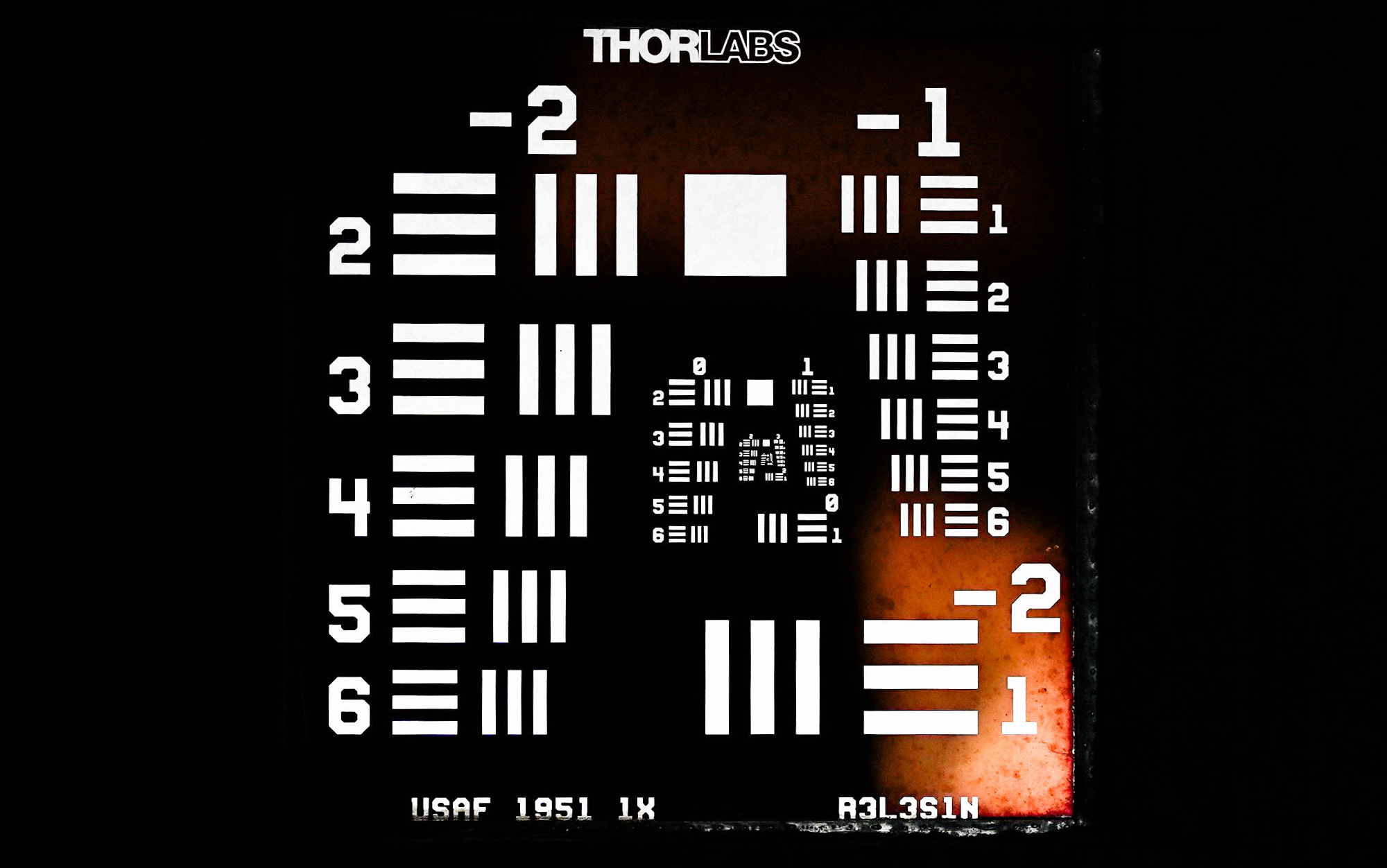
We put all compact-scope submissions through the same criteria. First, we measure optical resolution using the diminishing black-and-white lines of a 1951 Air Force Resolution Target to score the optical performance of each submission. We also measure the low-light performance of each submission by mounting them to tripods and focusing them at 200 yards at a black-and-white resolution target at twilight, all in order to measure the brightness of the glass.
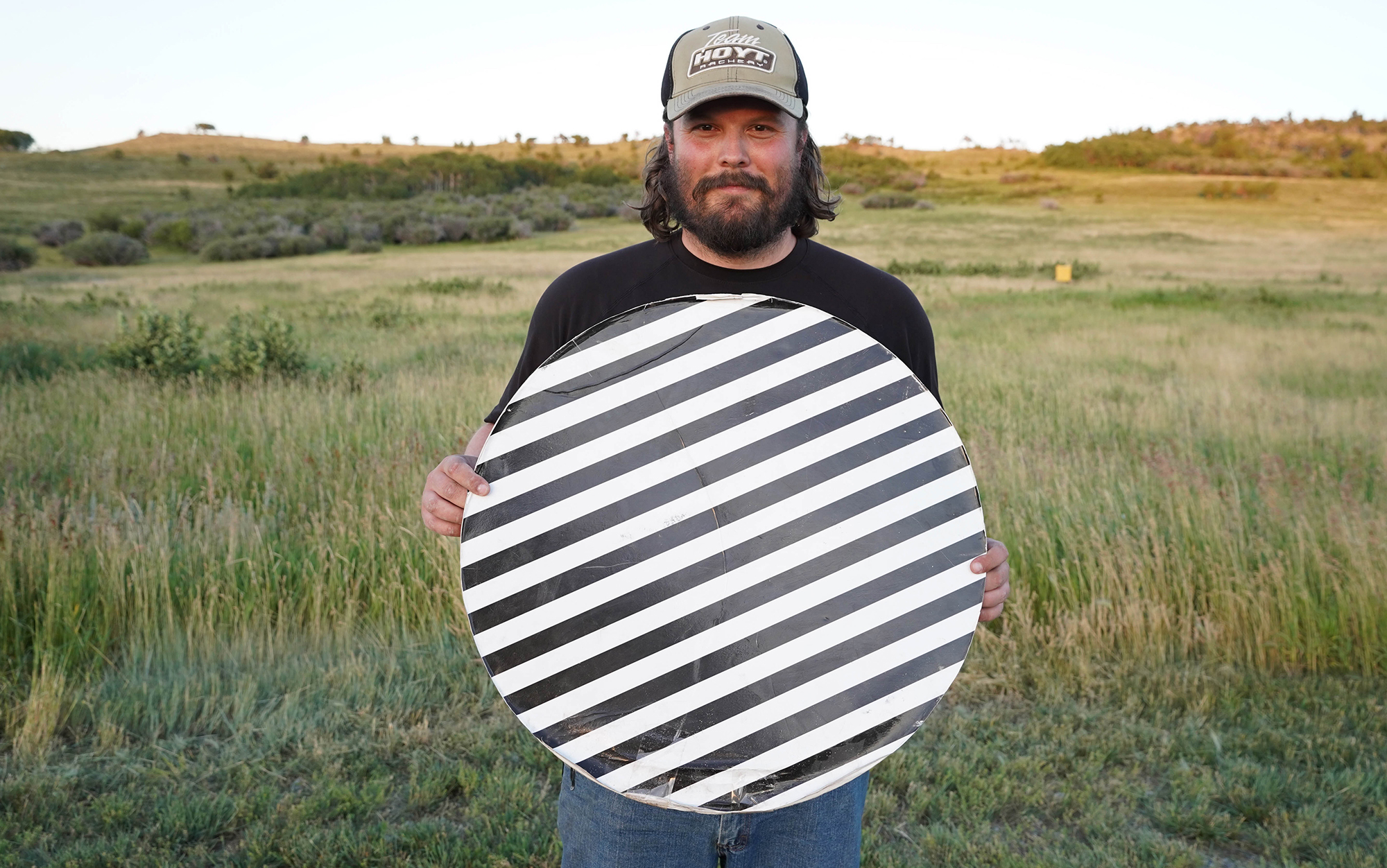
The scope that can “see” the longest into the gathering darkness gets top marks. The scope that loses its night vision earliest gets the lowest score. Scopes in the middle receive scores somewhere between those two poles.
We break our 10-point scoring into four general categories: optical performance, mechanical performance, design, and value. The average of these categories is the basis of our grades, detailed below.
Optical performance includes the resolution and low-light tests plus the more subjective image quality and brightness assessments. Mechanical performance assesses the durability of the submission along with its controls: focus and zoom, eyecups, and barrel rotation. The design considers the exterior finish, interior blacking, tripod mount, and its innovation and versatility along with its comfort, and for compact models, we also assessed their packability. We ask testers to evaluate this critical question: how long could you glass with this spotter?
And then our price/value score rates how much optic—along with warranty and amenities such as carrying case, additional eyepieces, or field cover—you’re getting for your money. The spotter that gets the highest overall score wins our Editor’s Choice award for the best in the category; the optic with the highest price/value score wins our Great Buy recognition.
Grading Optics
Our 10-point evaluation adds up to a total numeric score, but we translate those to grades for each submission. The Optical Performance grade combines the scores from resolution, low-light, image, and brightness. Our Mechanical Performance grade aggregates the mechanics and durability score. The Design grade considers Construction, Innovation, Versatility, and Comfort. And then the Price/Value grade is our value grade.
To earn an “Excellent” grade, the average of that category must be 9 or higher, which is extremely hard to achieve. “Very Good” is an average score of 7 to 9. A “Good” grade is 5 to 7. Our “Fair” grade is 3 to 25, and “Poor” is anything under 3.
Best Compact Spotting Scopes: Reviews & Recommendations
Best Overall: Swarovski ATC 17-40×56
Best Compact Spotter
Swarovski ATC 17-40×56
Score Card
- Optical Performance: Excellent
- Mechanical Performance: Excellent
- Design: Excellent
- Price/Value: Good
Key Features
- 56mm objective lens
- Angled eyepiece
- Center-barrel focus
- Polycarbonate chassis
- Removable foot
- Non-removable eyepiece
- Burnt-orange coloration
Pros
- Exceptional glass
- Just over 2 pounds
- Very portable and packable
- Removable half-shell for non-tripod viewing
- Digiscope friendly
Cons
- Pricey
- Limited utility
- Limited focus ring access when tripod-mounted
This compact spotter, clad in distinctive orange armor, simply stunned the test team. It is extremely bright, crisp, and the image it delivers is full of color and contrast. In short, it’s a world-class optic. That said, the team noted that, at $2,500, it will have a limited audience.
“This checks all the boxes for a premium compact spotter, but I don’t think most people want to spend over $2,000 for a mini-spotter,” says tester and OL gear editor Scott Einsmann. “I see this as an aspirational item rather than a replacement for a full-size spotter.”
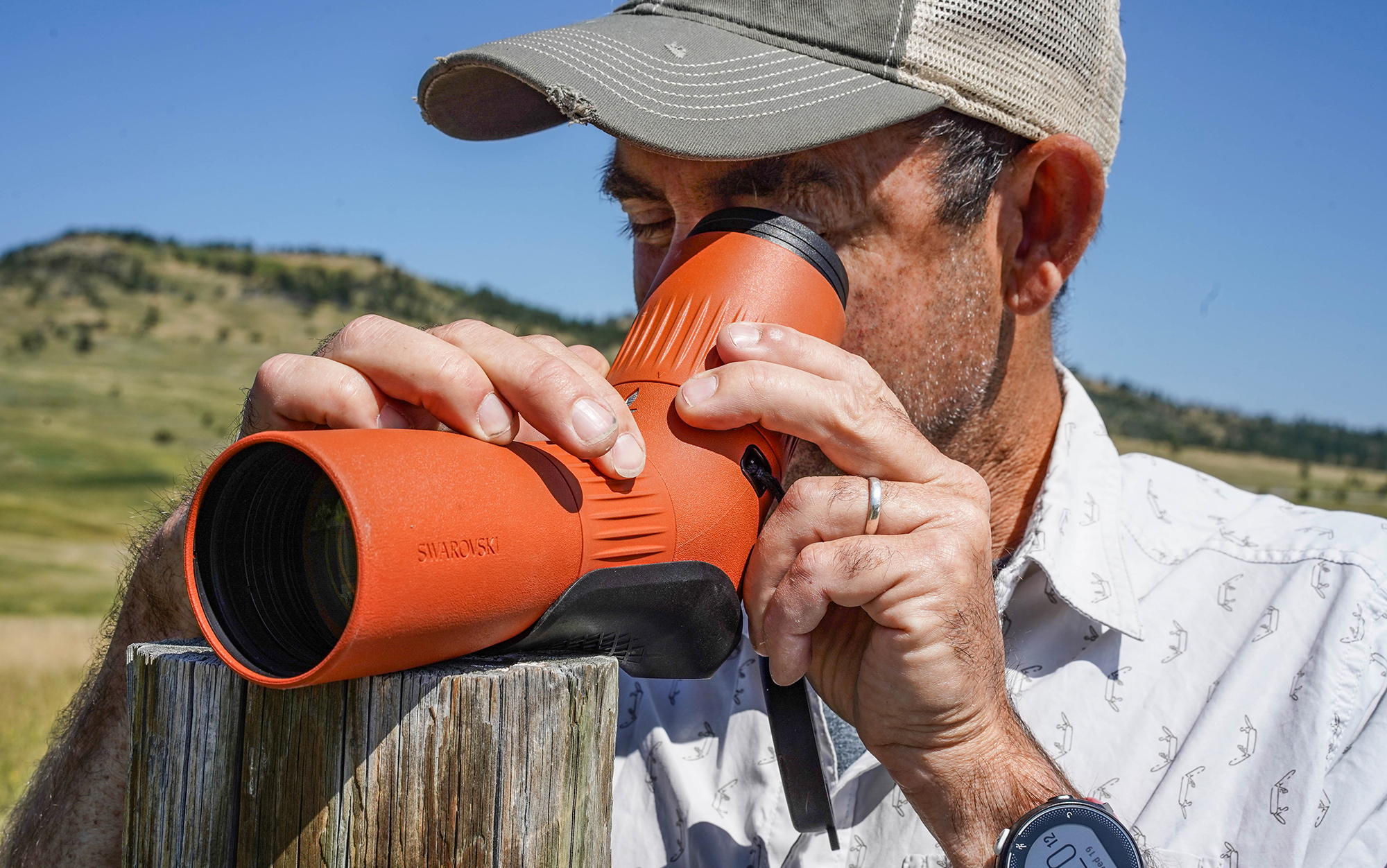
Fair enough, but the Swaro, which is the mini version of the brand’s modular ATC/BTX line of spotters, has plenty of field chops to go along with its aspiration. Its graceful lines, for which Swarovski could win industrial design awards, easily fit in a pack, and nicely balance the 2-pound heft. Mounted on a tripod, the center-barrel focus ring can be hard to access, forcing users to reach over the top to turn the dial with fingertips. But the ATC’s smart and useful “shoe” screws into the tripod receiver and gives the scope’s round body a flat surface on which to deploy it. Picture slapping the scope (with the half-shell shoe) on top of a wooden post or pickup tailgate, sans tripod. The focus ring is unencumbered by the shoe, which stabilizes the scope in any number of situations.
This is clearly not a scope for everyone or for every purpose. But it would be our choice for slinging in a pack for those times when you don’t want to carry a full- or mid-sized spotter and a tripod. As for all those other times when you’re not looking through it, the Swarovski ATC is mighty pretty to simply look at.
Best Value: Hawke Nature-Trek 13-39×56
Best Value
Hawke Nature-Trek 13-39×56
Score Card
- Optical Performance: Good
- Mechanical Performance: Good
- Design: Good
- Price/Value: Very Good
Key Features
- 56mm objective lens
- Angled dog-leg design
- Center-barrel focus
- Aluminum alloy chassis
- Non-removable eyepiece
- Ships with window mount and neoprene field cover
Pros
- Super compact porro prism design
- Just over 2 pounds
- Handy window mount
- Responsive controls
Cons
- Mediocre optics
- Some internal dust
The consensus pick for our best value in the compact spotting scope category, this little marvel has a length of just over 9 inches and weighs 2 pounds. Introduced earlier this year, the Nature-Trek ships with a handy window mount and a fitted neoprene field cover, further boosting its value.
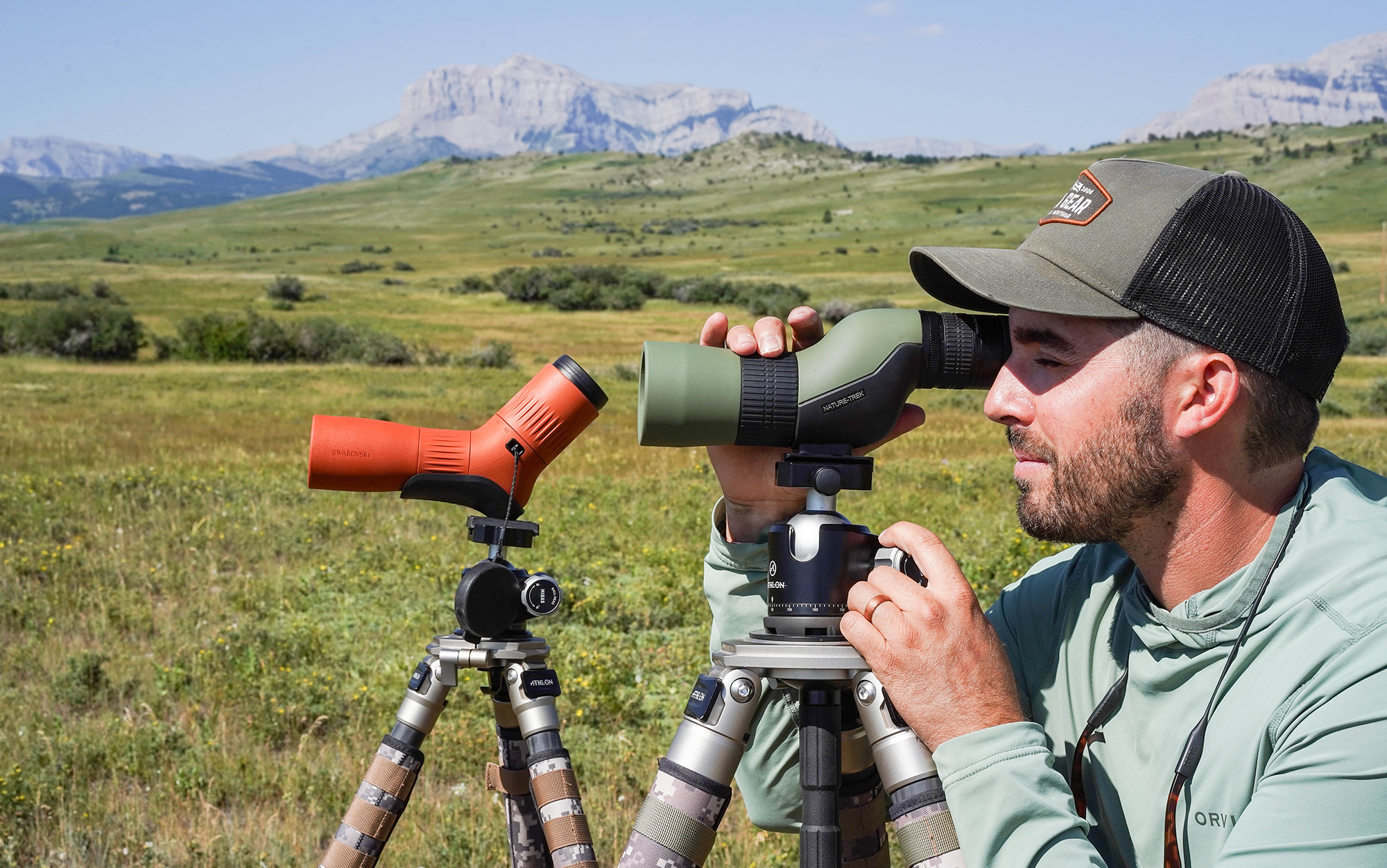
We were unimpressed with the optical performance, at least compared with the class-leading Swarovski and Maven, but that’s to be expected in a unit that costs a cool third of the latter two submissions. The image, delivered by standard glass, is adequate for most purposes, and the Nature-Trek held its own in both our low-light and resolution tests.
We’d like to see the same Arca-Swiss foot that Vortex employs on its Razor HD, and some testers noted a bit of dust and debris inside the Hawke, evidence of sub-optimal construction. But the unit’s focus and magnification controls turned with precision, and the 14-foot close focus makes it a handy optic for birders and butterfly enthusiasts.
Supported by a tabletop tripod, this would make an excellent range scope. And, at just over $300, it’s a bargain for an extremely packable compact spotter.
Read Next: Best Binoculars for the Money
New Launch: Vortex Razor HD 13-39×56
Score Card
- Optical Performance: Excellent
- Mechanical Performance: Good
- Design: Very Good
- Price/Value: Good
Key Features
- 56mm objective lens
- Angled eyepiece
- Center-barrel focus
- Magnesium chassis
- Arca-Swiss compatible tripod mount
- Removable eyepiece
Pros
- Premium glass
- New size in Razor line
- Ships with neoprene field cover
- Excellent controls
- Simple tripod mount
Cons
- Eyepiece attachment is jinky
- Barrel doesn’t rotate
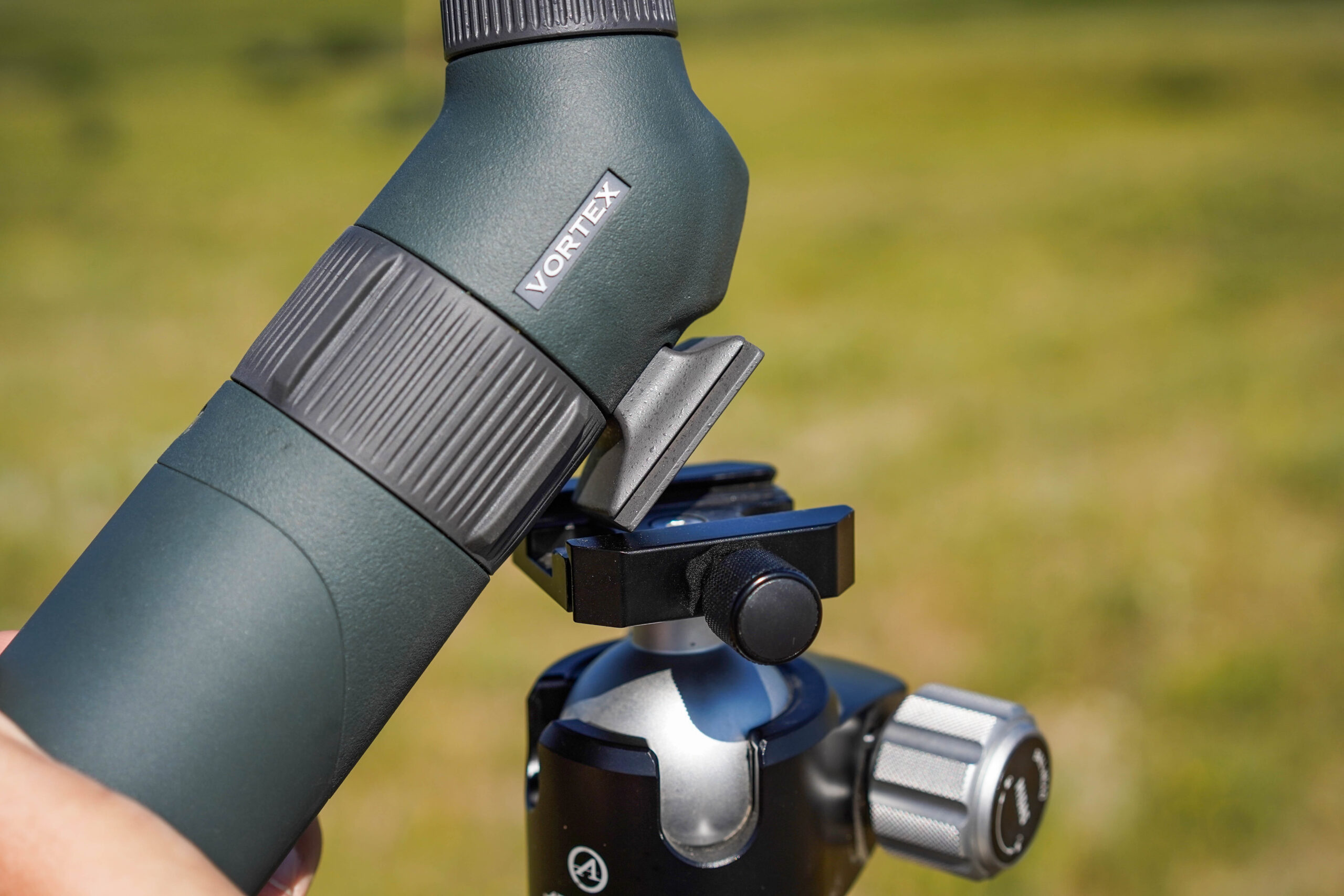
A smart and capable newcomer to Vortex’s excellent Razor HD line, this wee spotter delivers an image much larger than its stature. Its premium glass tames color flaring and other optical aberrations, and the combination of coatings and glass quality elevated the Razor HD to the top low-light performer of the compact scope category. It finished just behind the excellent Swarovski in resolution, as well.
If only the spotter’s mechanics matched its glass. The eyepiece attachment gave the test team fits, easily cross-threading with no clear indication of when the attachment is properly seated. A metal collet that protects the threads further came loose, exposing the optic’s interior to dust and moisture. Testers also recorded that the focus and magnification ring were distractingly stiff.
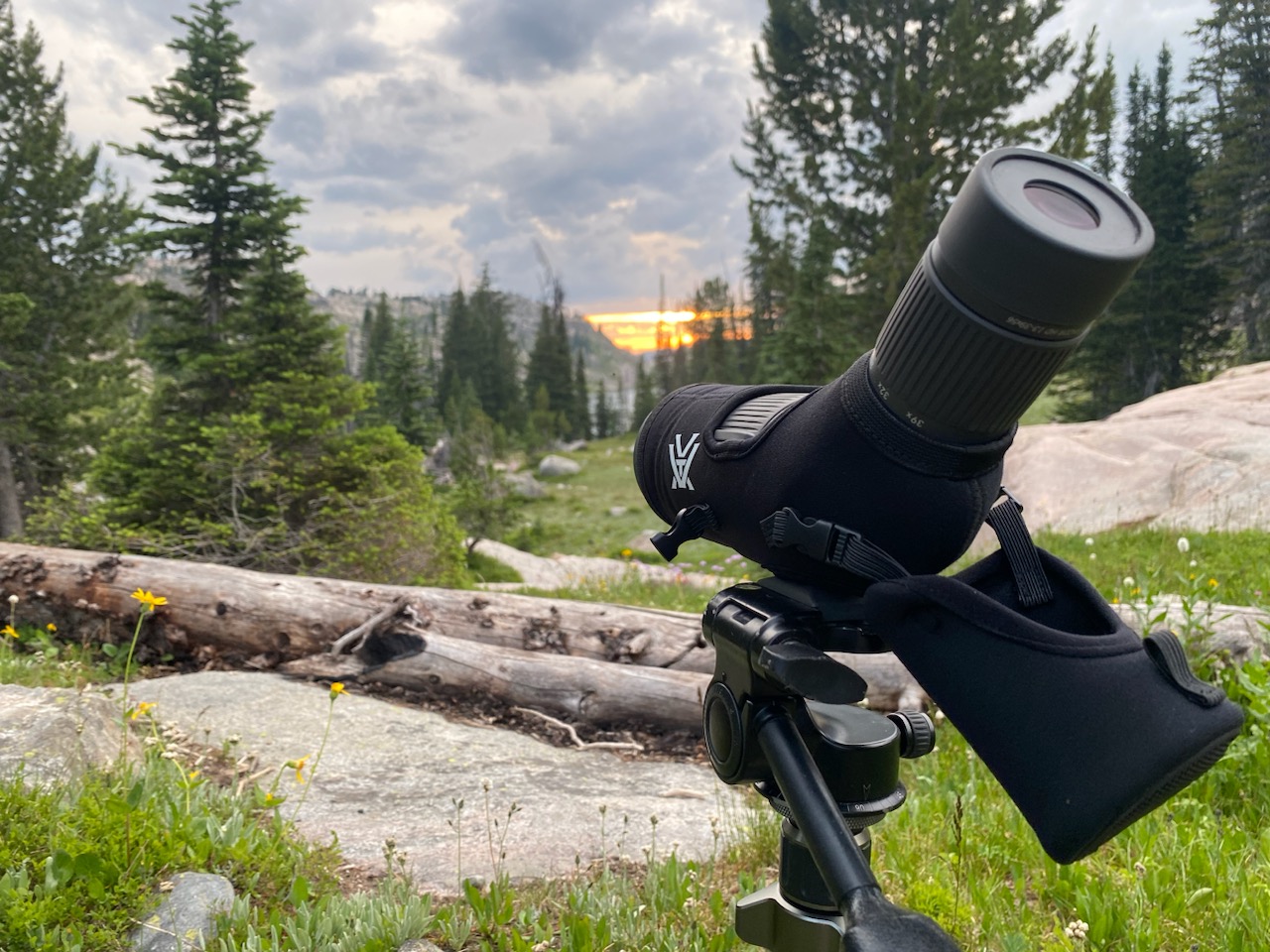
But the Razor HD has enough other talents to offset those mechanical deficiencies. We love the tripod mount, compatible with Arca-Swiss tripod heads. This simple design enables direct mounting, without messing with a separate mounting plate. The pebbly exterior is easy to grip and resists dust and scratching, and the balance is among the best in the class. Plus, testers noted Vortex’s excellent warranty and accessible price, especially considering the scope’s premium optics.
Maven S.2
Maven S.2
Score Card
- Optical Performance: Very Good
- Mechanical Performance: Very Good
- Design: Very Good
- Price/Value: Very Good
Key Features
- 56mm objective lens
- Straight-barrel design
- Center-barrel focus
- Magnesium/polymer chassis
- Non-removable eyepiece
Pros
- Extremely tactile texturing on controls
- Distinctive gray/black/orange accents
- Twist-up eyecup
- Rugged, easy-gripping armor
- Premium fluorite glass in objective lens
- Straight design easy to pack
Cons
- Slight edge distortion
- Shallow focal length
One of the shortcomings of compact spotters with angled eyepieces is that they don’t normally rotate. That means that you can’t change the orientation of the optic to your eye, a major hindrance if you’re glassing from a window mount or trying to share the optic with a partner on a sidehill. Happily, the straight-barrel Maven doesn’t have that problem. What you see, literally, is what you get with the design.
That’s only one plus of this handy, bright, and extremely packable spotter. The other, of course, is that the 11-inch tube slips easily in a backpack pocket, making it—along with Leupold’s Gold Ring—the most portable of the class. The glass is excellent, leading with premium fluorite glass in the objective lens and fully multi-coated lenses inside. The controls are positive without being overly resistant, meaning they turn with casual authority. And the looks, orange accents above the gray-and-black exterior, are head-turning.
The S.2 was introduced way back in 2019, but if it now is considered a legacy submission, it was years ahead of its time, since it now conforms easily to the new sub-compact category of spotters. In all, it’s a bright, capable optic that bridges the gap between binoculars and full-size spotters.
Leupold Gold Ring Compact 15-30×50
Leupold Gold Ring Compact 15-30×50
Score Card
- Optical Performance: Good
- Mechanical Performance: Poor
- Design: Fair
- Price/Value: Good
Key Features
- 50mm objective lens
- Angled dog-leg design
- Side focus
- Magnesium chassis
- Non-removable eyepiece
- Ultra-compact design
Pros
- 21.5 ounces, lightest in the test
- 11 inches long
- Extremely packable
- Ships with fitted neoprene field cover
- Distinctive shadow-gray color
- Useful without tripod
Cons
- Unstable tripod mount
- Power ring turns hard
- Right-side focus awkward for lefties
The test team badly wanted to love this scope. It descends from spotting-scope royalty, Leupold’s excellent Gold Ring and Mark 4 lines. But a couple of demerits knocked this ultra-compact version into the realm of good, but not great, spotters. The main problem we had was the wobbly connection to a tripod, a situation that left us unable to achieve precise spotting at any distance. The problem stems from a plastic-on-plastic interface between the scope’s body and the tripod adaptor. Once we shimmed the adapter and found imaginative ways to tighten the connection, the unit performed well enough to keep it in the test.
The glass is good, but not quite on par with the premium scopes in this year’s test, but the 50mm objective lens, much smaller than its 56mm peers, kept it toward the bottom of our low-light test. Other testers complained that the reverse porro-prism design—Leupold calls this its “Folded Light Path”—doesn’t point instinctively and was hard to get on target.
Those deficiencies out of the way, this is among the most packable scopes in the compact field. Weighing only 21 ounces and measuring only 11 inches, it goes everywhere. Plus, the design is intended to be used without a tripod, by wedging the scope in a tree branch or pack frame. That helps explain why the tripod mount isn’t a deal-breaker. The size, magnification range, and overall handling make this a good alternative to a 15-power binocular and a useful companion on a backcountry hunt.
Read Next: Best Spotting Scopes
How to Choose a Compact Spotting Scope
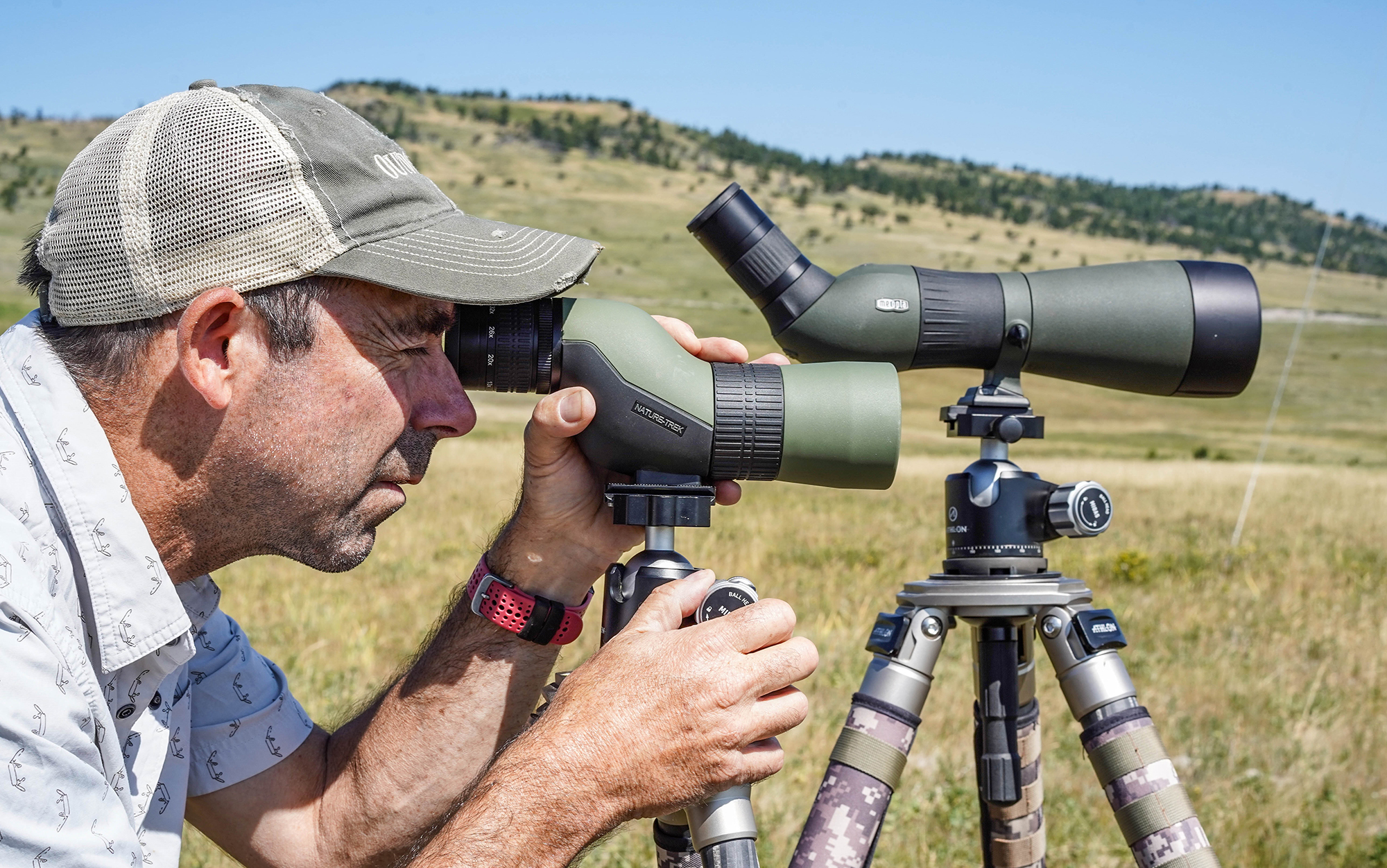
There’s an inverse proportion that’s useful to consider when shopping for a compact spotting scope. It’s the reverse of price per pound. Because you want as light and nimble a scope as possible, but still want to put your money into the best glass you can afford, the best compact spotters are those that weigh the least but offer the best optical performance.
We tried to find that sweet spot with our test. Yes, the very best scopes have premium glass and components and correspondingly high prices. But there are some very good values in the next group, those that cost half the price of a premium scope but offer 90 percent of their performance.
But even average spotters can cost upwards of $600. With that in mind, you want to be sure you’re buying the best scope for your use. If you’re reading this, then you probably already know that a 56mm spotter is a better choice than the behemoth 80mm and even 86mm units. Next, consider whether you want an angled or a straight-body scope. I prefer angled scopes because of their versatility. I can easily deploy one on a steep hill, and by rotating the barrel, I can share the scope with a buddy sitting beside me without ever moving the scope.
Other considerations: center-barrel focus or fingertip focus close to the eyepiece. Also magnification range. Most compact scopes have 13- to about 30-power magnification zoom ranges that cover most practical glassing purposes at middle distances, but if you need more magnification, you’ll probably pay for it.
Look for spotters that have fully transferable lifetime warranties, good customer service, and solid reputations. After all, you’re going to be laying out a lot of cash for this spotter, and you want to make sure the company stands behind their product.
Why Trust Outdoor Life?
Since 1898, OL has been a leading authority in testing and reviewing hunting gear, fishing tackle, guns and shooting equipment, and much more. We have more than a century-long history of evaluating products, and we’re now bringing that expertise to online reviews. Our editors are experienced outdoorsmen and women, and most importantly, we’re trained journalists. We prioritize field testing and objective data when reviewing products. We conduct interviews with gear manufacturers and engineers as well as outdoor experts so that our readers have an understanding of how and why a product works—or doesn’t.
Advertising does not influence our gear reviews and it never will. While we always focus our coverage on standout products—because we want our readers to be aware of the latest and greatest gear—we also cover the flaws and quirks of any given product.
Final Thoughts
This was the first year we tested the best compact spotting scopes that have been on the market for a few years against new-for-’23 products, and we were both surprised and delighted to see the oldies pull their weight. That’s an indication that optics built with premium components and durable construction retain their value, and for buyers it means that you might find some very good deals on scopes that are being discontinued.
- Best Overall: Swarovski ATC 17-40×56
- Best Value: Hawke Nature-Trek 13-39×56
- New Launch: Vortex Razor HD 13-39×56
- Maven S.2
- Leupold Gold Ring Compact 15-30×50
